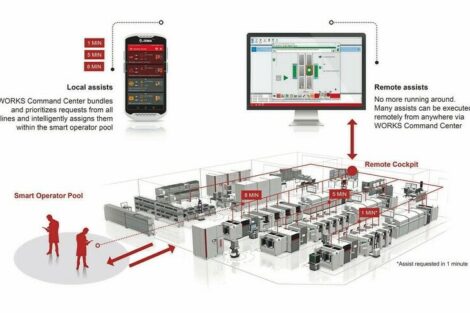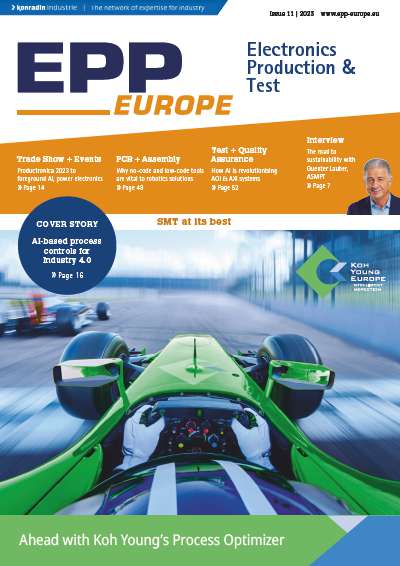How is the current situation?
Lead-free isn’t new. Many users have used Pb-free alloys for some time where they wanted higher melting point or particular materials properties. What is new is to use lead-free solder on assemblies previously made with tin-lead or silver, respectively.
How about soldering temperature?
Reflow temperatures are higher for lead-free, and this may be over the limit for some components. Reflow with tin-cooper alloy is possible at 230°C, and thisis acceptable for most parts. Manufacturers are being asked to qualify components to 260°C. In wave, there is less of a problem, as components are not exposed to the full solder temperature anyway. Current boards generally tolerate the higher temperatures, though there is some tendency for discoloration of some materials at reflow temperatures above 230 to 240°C.
What about reliability?
Taking the data (temperature cycling, power cycling, vibration) as a whole, the conclusion is that reliability of joints is about equivalent to Sn62/63. Individual results can be selected to show that a particular alloy is better, but overall they come out about the same.
Are there any compatibility issues?
Amalgamation of lead-frees with tin-lead will give a solder with a long pasty range (solidus at 183°C). Joints may look rough and dull. In reflow or single-sided wave, some Pb-contamination from component leads can be accepted, as there is no impact on reliability. In wave soldering of through-hole boards, no Pb is permissible, as pin-fillet lifting can occur. There is good compatibility with finishes such as OSP, Cu, AuNi, immersion-Sn, immersion-Ag, HAL and SnCu. Lead-frees containing tin with Ag, Cu, Sb are compatible with each other.
What types of finishes are available?
In the case of reflow and single-side wave soldering, conventional HASL is fine, and there is experience with lead-free HASL. All above mentioned finishes have worked well, the same applies about their solderability. Poor quality batches probably don’t work better or less well than they would with SnPb. Wetting out on Cu/OSP is visually inferior compared with SnPb. The solder wets where it is printed. All standard finishes on components work well, but Sn/Pb is not acceptable for through-hole wave soldering. Bare AgPd metallization is also not a good idea. Lead-free alloys leach it too rapidly, and a Ni-barrier and solderable coating (Sn) is recommended.
How about wetting?
Spread on copper in particular is less than for SnPb due to the higher surface tension of lead-free alloys. Thus, wetting angles are higher. Pb-frees are usually soldered at a lower superheat above the melting point, and this will make wetting look worse.
What about joint mechanical properties?
Tin is the ”active” ingredient in both tin-lead and Pb-free solders, so the mechanism of wetting and bonding is the same. Lead-free joints are not brittle, and will not be damaged by pin testing. Pb-free joints have much higher creep strength and better high-temperature strength than Sn62/63.
Do we need to use nitrogen?
It is not necessary to solder under nitrogen, but an inert atmosphere does assist wetting and would generally widen the process window.
Are the joints rough?
Lead-free alloys, although eutectic, do not freeze with a pure eutectic microstructure. The result is a microscopically rough surface with tin dendrites (crystals) in relief, which looks dull to the naked eye.
How is Pb-free going to effect flux systems?
Users can start with a lead-free process using the same flux as in their conventional process. In the case of cored wire, there is no need for refinement. Very low residue (no resin) wave-soldering fluxes might stand slightly higher activity levels to compensate for the greater destruction/volatilization of the flux, but this is not certain. Solder paste provides the greatest opportunity in flux development. Medium and low-solids pastes are likely to need nitrogen, but higher solids paste will give good performance in air. Increasing the solids content and the activator level in no-clean paste seems to be essential to give a good process window. Care is needed to design fluxes that do not leave voids in the solder. These are not really functional defects (except where heat conduction is a key function of solder joints), but manufacturers using X-ray inspection will not be happy at the potentially higher level of voids.
What changes will be required for wave process?
The trick is to get enough heat into the board to ensure good flow of the solder, and this is achieved by higher preheat, higher bath temperature and longer contact time. The actual increase depends on the thermal capacity of the board and all the usual parameters that affect topside fillets on double-sided boards.
Any new issues for printing?
Reflow is really the only condition that changes with lead free. There are some second-order effects, but there is no evidence now that they are noticeable in a normal process. Printing, open time, tack, slump, etc. are all the same as the equivalent SnPb product. The key feature is that the volume of powder in SnPb and lead-free pastes should be the same. Since the Pb-frees are less dense than SnPb, the weight is lower to give the same volume of powder. A typical reduction will be 90% for SnPb, down to 88.5% for lead-frees. Since the volume of powder remains unchanged, stencils do not have to be altered, and the same volume of solder ends up in the joint.
What about auto dispensing?
There is lead-free paste available for dispensing applications. Such dispensable paste comes in a variety of alloys and flux choices. The metal loading ranges from 84 to 86%, depending on alloy density and application. Metal loading of lead-frees will be less than with traditional Sn62/63 solder paste due to the decreased density of Pb-free alloys.
What can l expect at post soldering?
The changes from SnPb residue behavior are all associated with the increased time and temperature the flux is exposed. Cleaning will be more difficult, and residues will be harder. This may not affect pin-contact resistance, but it will probably increase the production of debris that contaminates the board and the test pins. Maintenance will probably increase. Pb-frees are at least as corrosion-resistant as the SnPb systems, so typical environment conditions present no special problems.
Will the Pb-free process comply with SIR specification?
The residues of no-clean flux will not show any measurable change in their ability to pass SIR (surface insulation resistance) tests.
What are the hazards for operators?
The hazard of lead is removed. However, the flux fumes given off at soldering temperature indicate that these materials should always be used in well-ventilated areas, and suitable care should be used to prevent materials from contacting skin and eyes.
How do l rework lead-free joints?
There is no change in the rework process. Pb-free wire, paste and flux systems are available.
Many different pressing questions which users can encounter before or during the transition to Pb-free processes, are summarized here. They are just the starting point for deeper, more profound research on the subject, but ideally suited for beginners as a short overview.
ZUSAMMENFASSUNG
Welcher noch unerfahrenene Anwender möchte sich nicht einen raschen Überblick über die drängendsten Fragen bei der Einführung von bleifreien Produktionsprozessen verschaffen? Als Antwort auf diese eher rhetorische Frage hier eine Darstellung aus Sicht des Pastenlieferanten Multicore.
RÉSUMÉ
Tout utilisateur encore inexpérimenté souhaite disposer d’un aperçu d’ensemble rapide des questions les plus urgentes en matière d’introduction de processus de soudage sans plomb. Pour répondre à cette question plutôt rhétorique, voici un récapitulatif du point de vue d’un fournisseur de pâtes, Multicore.
SOMMARIO
Quale utente non ancora abbastanza esperto non vorrebbe avere una rapida visione d’insieme sulle più frequenti questioni riguardanti l’introduzione di processi di produzione senza piombo? Come risposta a questa domanda piuttosto retorica, qui una rappresentazione dal punto di vista del fornitore di paste Multicore.
Share:









